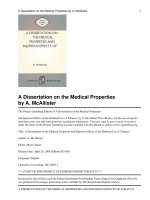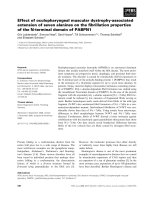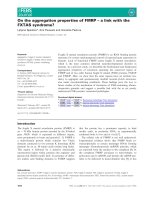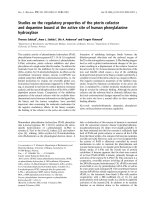Effect of welding parameters on the mechanical properties of friction-stir-welded heat-treatable AA6061-t6
Bạn đang xem bản rút gọn của tài liệu. Xem và tải ngay bản đầy đủ của tài liệu tại đây (794.09 KB, 8 trang )
Vietnam Journal of Science and Technology 57 (6) (2019) 677-684
doi:10.15625/2525-2518/57/6/13808
EFFECT OF WELDING PARAMETERS ON THE MECHANICAL
PROPERTIES OF FRICTION-STIR-WELDED HEAT-TREATABLE
AA6061-T6
Tran Hung Tra
Nha Trang University, 02 Nguyen Dinh Chieu, Nha Trang City
*
Email:
Received: 10 May 2019; Accepted for publication: 17 October 2019
Abstract. The effect of welding parameters on the mechanical properties of the friction stir
welding of heat-treatable 6061-T6 was experimentally investigated. The influence of the
welding rates on the hardness, tensile strength, bending strength, and the impact energy of the
welding was investigated. The alloy 6061 could be welded with free defects. The mechanical
properties were sensitive to the welding regimes and the location in and around the welded zone.
Both the tensile and bending strengths of the joint were quite low compared to those of the base
alloy 6061. The bending ductility of the joints was improved significantly. While the impact
resistance around the welded zone was higher than that of the base alloy, the impact resistance at
the weld center was remarkably low.
Keywords: friction stir welding AA6061-T6, hardness, tensile strength, bending strength, impact
energy.
Classification numbers: 2.9.1, 5.1.4.
1. INTRODUCTION
With high specific strength, aluminum alloys have been applied spreadly in high-speed
industry. One of the obstacles in using the high strength aluminum alloys associating with
joining them by welding [1]. Friction stir welding (FSW), invented by The Welding Institute
(TWI) in 1991, has been emerging as a key technology for welding alloys previously regarded as
unweldable [2 - 3]. In the friction stir welding process, the material in the welded zone is heated
and plasticized by friction process induced by the kinetic friction at the contact surface between
the rotated non-consumable tool and the workpieces. The friction stir welding process is a
thermo-mechanical plastic deformation in which the microstructure is dramatically
recrystallized. As a result, the welded zone possesses several microstructure features and
mechanical properties [4 - 9]. Aluminum alloy 6061 (named AA6061) is a heat-treatable
aluminum alloy and is widely applied for transportation facilities. The mechanical properties of
the welded joints of this aluminum alloys need to be explored clearly to expand the application.
Recently, the friction stir welding of both the similar AA6061 and dissimilar AA6061 with other
aluminum alloys are addressed [10 - 11]. This work aim is to investigate the effect of the
welding rate (at a constant rotation speed) of the tool on the mechanical properties of the FSW
butt-joint of AA6061-T6 plate 5.0 mm thickness.
Tran Hung Tra
2. MATERIALS AND EXPERIMENTS
The 5.0 mm AA6061-T6 plates were joined by friction stir welding technique in the
Friction Welding Lab of Nha Trang University. Table 1&2 showed the properties of the
aluminum alloy 6061. The tool geometry used in this FSW is a 20 mm shoulder diameter, a
truncated cone pin with the screw pitch of 1.0 mm in which the pin diameter at the middle pin
length is 5 mm. The tool shoulder is 20.0 mm in diameter. The pin is aligned at a tilt angle of
2.0o. The FSW joints were fabricated with several welding speed rates (denoted WSR). The
attention was put on the effect of the tool welding speed. The tool rotation was kept constant at
600 rpm, and other parameters were kept constant. After being fabricated, the cross-section of
the welding was polished and etched to observe the defects and grain microstructure with a
solution of 150 ml H2O, 3 ml HNO3, 6 ml HCl and 6 ml HF. The defects and microstructure
were observed by a high magnification microscope, using a microscope combined with a
magnification computer connector. The hardness was measured by a diamond indentation with
50 g loading with 10 seconds of hold time. The tensile and bending strengths of the FSW 6061T6 were measured by the 5.0 mm thickness plate specimens. The specimens were machined in
which the loading direction was perpendicular to the weld direction of the FSW plate as shown
in Figure 1. The tensile and bending specimen geometries were determined by ASTM- E08 and
ASTM-E290, respectively. The tensile and bending tests were performed by the Instron 3366
machine at 10-3/s constant strain rate. The impact tests were performed by the impact-machine
IT406M. The impact specimen geometry was determined by ASTM-E023.
Table 1. The chemical composition of AA6061 aluminum alloy [12].
Element
Al
Mg
Cr
Cu
Si
Zn
Mn
Ti
Percentage (%)
Bal.
0.85
0.06
0.22
0.68
0.07
0.32
0.05
3. RESULTS AND DISCUSSION
Many welding speed rates were performed for fabricating the joints to study the effect of
the welding regimes on the mechanical properties of the FSW joint of aluminum 6061-T6. The
welding process and the fabricated plate of FSW AA6061-T6 are shown in Figure 1(d). Figure 2
showed a typical microstructure of the FSW 6061-T6 (fabricated at WSR = 2.0 rev/mm). Here
the microstructure in the welded zone was recrystallized dramatically. In general, the grain sizes
in the stirred zone (about 20 m) was quite fine in comparison to that of the base alloy (about 80
m), see region III and region I in Figure 2.
The hardness distributions measured at the middle-line in the cross-sections are shown in
Figure 3 as a function of the welding parameter, WSR. In general, a significantly softened feature
in and around the welded zone is observed in all FSWs. The softening appearing in and around
the welded zone could be related to the dissolution and/or coarsening of precipitates in this alloy
[1]. It was also found that, in all cases, the lowest hardness in the cross-section of the FSW is
placed on the heat-affected zone (HAZ) in the advancing side and/or retreating side, outside the
stirred zone (see Figure 3). The fact that the hardness in the stirred zone is higher than that in
HAZ might be associated with a high density of grain boundaries in the stirred zone or Hall
Petch effect [13].
The measurement of the tensile strength of the FSW 6061-T6 was carried out by the Instron
3366 machine at a constant strain rate of 10-3/s using of the specimen shown in Figure 1.
678
Effect of welding parameters on the mechanical properties of friction-stir-welded heat-treatable …
a) Tensile specimen geometry.
b) Bending specimen geometry.
c) Impact specimen geometry.
d) The fabricated FSW plate AA6061.
Figure 1. Geometries of the experimental specimens used in the work and the FSW 6061 plate.
Figure 2. Microstructure in the cross-section of FSW fabricated at WSR of 2.0 rev/mm.
679
Tran Hung Tra
Figure 3. Hardness distribution across the welding cross-section (measured at the middle line).
Figure 4. Tensile failures in the FSW under various welding regimes.
Figure 5. Tensile properties of the FSW under various welding regimes
(the tensile strength of the joint was normalized to that of base alloy 6061).
680
Effect of welding parameters on the mechanical properties of friction-stir-welded heat-treatable …
The tensile failures of all FSW specimens took place in the stirred zone or in the HAZ (on
the advancing side or on the retreating side) as seen in Figure 4. All specimens fractured in the
stirred zone were induced by the tunnel defects there. The tensile strength of the joint was
presented in Figure 5. In the regime, WSR of 2.0 rev/mm, the defects were eliminated and the
tensile specimens were fractured outside the stirred zone, in the HAZ. It can be seen in Figures
3&4 that the tensile fracture locations were taken place in the HAZ in the advancing (AV) side
where the lowest hardness in the joint. The lowest hardness location and the lowest tensile
strength in the joint is well agreed and reasonable in this case.
The results of the bending test for both the base alloy and the welded specimens were
shown in Figure 6. Almost all the bending specimens were cracked and initiated at the bottom
line defects of the joint as seen in Figure 6. The joint seems to be successfully fabricated at WSR
= 2.0 rev/mm, here the joint was bent with no crack (Figure 6). The bending strength of the joint
was lower than that of the base alloy. The maximum strength of the welding is about 75 % of
that of base alloy 6061 (Figure 7). The reduction of the bending strength might concern the low
hardness in the welded zone. However, interestingly, the bending ductility of the welded joint
was improved significantly compared to that of base alloy 6061 (Figure 7). This enhanced
ductility of bending might associate with the refined microstructure in the welded zone.
Figure 6. Bending failures in the FSW under various welding regimes.
The impact resistance of the joint was quite sensitive to the location in the welding as seen
in Figure 8. Here, at the weld center location of the joint, the impact resistance of the welding
was remarkably low in comparison to that of the base alloy. In the heat-affected zone and the
thermo-mechanical zone (5.0 mm away from the weld center), the impact resistance of the joint
681
Tran Hung Tra
was remarkably higher than that of the base alloy 6061 (Figure 8). The fluctuation of the impact
resistance at different locations across the welding might associate with the change of ductility
across the joint. The lower impact energy took place at the weld center with all welding regimes
might concern the tunnel defects and kissing bond in this area. However, at the welding regime
with 2.0 rev/mm, where the defects seem completely eliminated, the impact energy at the weld
center still lower than that of base alloy 6061. This strange phenomenon will be clarified in the
next works.
Figure 7. Bending properties of the FSW under various welding regimes
(the bending strength of the joint was normalized to that of base alloy 6061).
Figure 8. Impact energy at various locations in the FSW (at weld center (WC), at 5 mm away
from weld center (TMAZ-AV), at 10 mm away from weld center (HAZ-AV).
4. CONCLUSIONS
The FSW of aluminum alloy 6061-T6 was fabricated and the effect of welding rates on its
hardness, tensile strength, bending strength, and impact resistance of the joint were evaluated.
The joint was softened significantly in and around the welded zone. In tensile and bending tests,
682
Effect of welding parameters on the mechanical properties of friction-stir-welded heat-treatable …
almost all of the joints were fractured in the welded zone. Only at the welding regime, WSR =
2.0 rev/mm, the joint was fractured outside the welded zone for both tensile and bending tests.
Both tensile and bending strength of the joint in all welding regimes were quite lower than those
of the base alloy 6061. The highest tensile strength and bending strength of the joint were about
65 % and 72 % of those of base alloy. The impact resistance was significantly sensitive to the
location across the welding. Generally, the impact resistance of the joint was higher than that of
the base alloy. At the weld center, the impact resistance of the welding was quite low compared
to that of the base alloy.
Acknowledgements. The author is grateful to Phi Cong Thuyen, a technical officer in the Friction Stir
Welding Lab in Nha Trang, for his support in experimental works.
REFERENCES
1.
Sachindra J. D., Gohilb A. V., Mehtaa N. D., Vaghasiyac S. R. - Challenges in Fusion
Welding of Al alloy for Body in White, Materials Today: Proceedings 5 (2018) 6370–
6375.
2.
Gene M. - The welding of aluminum and its alloys, Woodhead Publishing Ltd, Cambridge
England, 2002.
3.
Mishra R. S., Mahoney M. W. editors - Friction Stir Welding and Processing, ASM
International, 2007.
4.
Tran Hung Tra - Effect of weld parameters on the mechanical properties of friction stir
welding AA6063-T5, ASEAN Engineering Journal 2229-127X 4 (2011) 73-81.
5.
Tran Hung Tra, Seino M., Sakaguchi M., Okazaki M. - Fatigue crack propagation
behavior relevant to inhomogeneous microstructure of friction stir welding AA6063-T5,
Journal of solid mechanics and materials engineering 4 (6) (2010) 840-848.
6.
Tran Hung Tra, Masakazu Okazaki, Kenji Suzuki - Fatigue crack propagation behavior of
friction stir welding AA 6063-T5: Residual stress and microstructure effect, International
Journal of Fatigue 0142-1123 43 (2012) 23-29.
7.
Aruna Prabhaa Prasad K., Kumar Puthab Balla, Srinivasa Prasad - Effect of Tool
Rotational Speed on Mechanical Properties of Aluminium Alloy 5083 Weldments in
Friction Stir Welding, Materialtoday: Proceedings 5 (9), Part 3 (2018) 18535-18543.
8.
Duong Dinh Hao, Tran Hung Tra, Vu Cong Hoa - Study of effect of friction stir welding
parameters on impact energy of AA7075-T6, Journal of Science and Technology, 54 (1)
(2016) 99.
9.
Phan Thanh Nhan, Tran Minh Khang, Tran Hung Tra - Investigation of AA5083 T-lap
joint fabricated by friction stir welding, Vietnam Journal of Science and Technology 57
(4) (2019) 457-467.
10. Jalal Fathi, Pejman Ebrahimzadeh, Reza Farasati, Reza Teimouri - Friction stir welding of
aluminum 6061-T6 in presence of water cooling: Analyzing mechanical properties and
residual stress distribution, International Journal of Lightweight Materials and
Manufacture 2 (2) (2019) 107-115.
11. Venkat Ramana G., Narsimhulu Sanke - Effect of tool rotational speed and feed rate on
similar and dissimilar Friction Stir welded joints of Al 5082 and Al 6061, Materials
Today: Proceedings, In press, 2019.
683
Tran Hung Tra
12. Devaraju Aruri, Kumar Adepu, Kumaraswamy Adepu, Kotiveerachari Bazavada - Wear
and mechanical properties of 6061-T6 aluminum alloy surface hybrid composites
[(SiC + Gr) and (SiC + Al2O3)] fabricated by friction stir processing, Journal of Materials
Research and Technology 2 (4) (2013) 362-369.
13. Callister W. D. - Materials Science and Engineering - An Introduction, John Wiley &
Sons, Inc., 2007, pp. 188-198.
684









